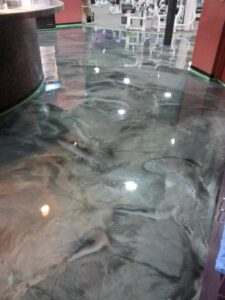Virginia, Commercial Natural Stone Restoration
Natural stone has been at the heart of architectural grandeur for centuries. Offering a timeless appeal, this material has been utilized in creating magnificent spaces and structures that stand testament to artistic prowess and human ingenuity. However, despite its strong and enduring nature, natural stone is susceptible to damage from external elements such as moisture, chemicals, or even daily wear and tear. This delicate material often necessitates a thorough restoration process when signs of deterioration appear or when a thorough cleaning becomes imperative.
The restoration journey involves comprehensive cleaning, sealing, and reviving of various types of natural stones, including the likes of marble, travertine, or limestone. This process not only eliminates all traces of dirt and stains, bringing back the lost shine and radiance but also enhances the material’s inherent durability. With no harsh chemicals used during restoration, the process ensures the stone’s protection from future harm, thereby extending its lifespan considerably.
The Rising Popularity and Potential Challenges:
The modern-day architectural landscape has witnessed a renewed interest in using natural stone for countertops and flooring. This inclination towards materials such as marble or limestone stems from their unique aesthetic appeal and enduring charm. However, these stones are inherently porous, which makes them vulnerable to damage if not maintained appropriately and cleaned at regular intervals.
The potential issues arising from improper care of natural stone are manifold:
- Acidic substances, such as lemon juice or wine, can lead to the formation of etches on the stone’s surface, marring its aesthetic appeal.
- The formation of stubborn stains, including burnt spots resulting from intensive scrubbing, accumulated grease, and more, can diminish the stone’s natural charm.
- Microscopic scratches on stone surfaces may lead to permanent staining, particularly if the surfaces haven’t been sealed adequately before cleaning.
- Inappropriate handling or furniture-induced scratches can adversely affect the appearance of the stone.
- Subpar installation techniques can result in cracks in the stone, compromising its structural integrity and aesthetic charm.
The Restoration Journey: An Investment in Time and Effort
Though restoration of natural stone demands significant investment in terms of time and effort, the outcome makes the process worthwhile. An old, worn-out surface is given a new lease of life, restoring the original beauty and charm. The restoration process involves several techniques, each aimed at a specific aspect of revitalization. After the surface has been adequately prepared, the process can be broadly divided into four crucial steps: grinding, honing, polishing, and grout filling.
Step 1: Grinding The restoration process commences with grinding. Using a specialized tool known as a diamond grinder, the initial focus is on removing surface imperfections and creating an even, flat surface. This step not only improves the appearance of the stone but also enhances the adhesion capacity of products designed to treat cracks or chips on the stone surface.
- Step 2: Honing After grinding, honing forms the next crucial step in the stone restoration journey. Honing, a less strenuous process compared to grinding, involves the application of a mixture of fine abrasive powder and water to the damaged or scratched area using a specialized honing machine. This step can effectively eliminate minor scratches, etching marks, and superficial stains from marble or granite countertops, thus reinstating their original sheen and smoothness.
- Step 3: Polishing Over time, due to constant usage and foot traffic, the color of your stone may fade or wear off. However, polishing can help restore its initial shine and richness. The process also rejuvenates hidden features in stones, such as the veins in travertine marble, making them prominent once again.
- Step 4: Grout Filling The final step in the restoration process involves the careful cleaning of joints followed by the application of a special grout filler. This process helps seal any gaps or seams on the stone’s surface, restoring the seamless appearance of your tumbled marble floor while providing a protective shield.
The Concrete Etc: Your Expert Partner for Commercial Natural Stone Restoration in VA As delineated above, there are multiple techniques involved in the process of natural stone restoration, each playing a pivotal role in maintaining the stone’s pristine condition. Whether it’s an exterior or an interior surface, these restoration processes help to keep your surfaces looking their best. At The Concrete Etc., we pride ourselves on our comprehensive knowledge and wide-ranging expertise in handling a multitude of surfaces and scenarios. Let us be your trusted partner in preserving the timeless beauty and durability of your natural stone.


 Step 1: Grinding The restoration process commences with grinding. Using a specialized tool known as a diamond grinder, the initial focus is on removing surface imperfections and creating an even, flat surface. This step not only improves the appearance of the stone but also enhances the adhesion capacity of products designed to treat cracks or chips on the stone surface.
Step 1: Grinding The restoration process commences with grinding. Using a specialized tool known as a diamond grinder, the initial focus is on removing surface imperfections and creating an even, flat surface. This step not only improves the appearance of the stone but also enhances the adhesion capacity of products designed to treat cracks or chips on the stone surface.